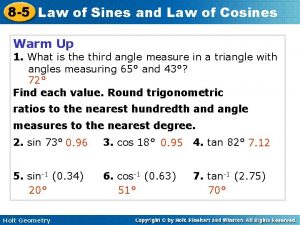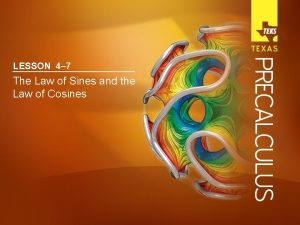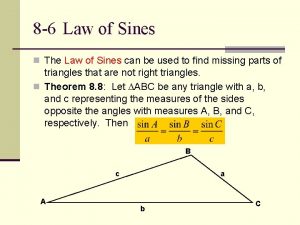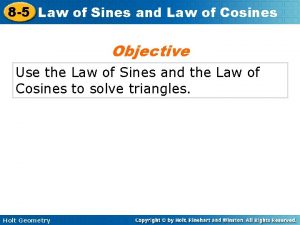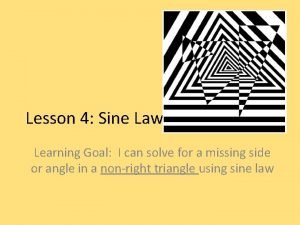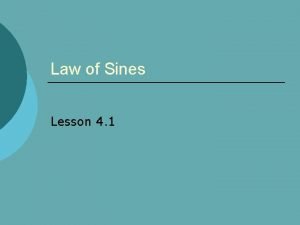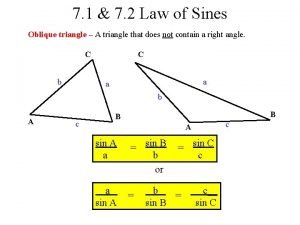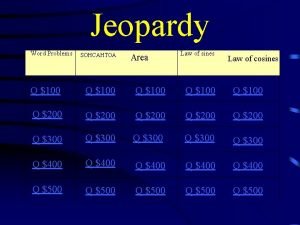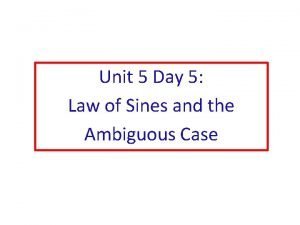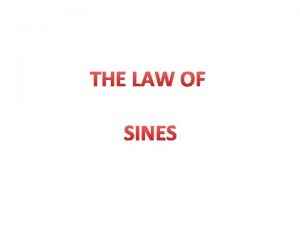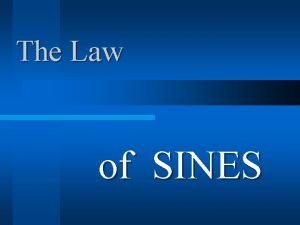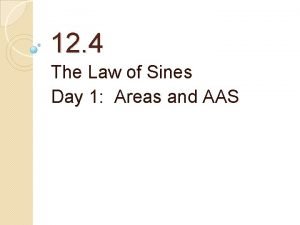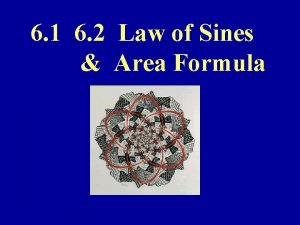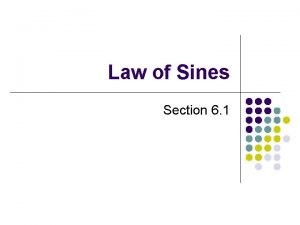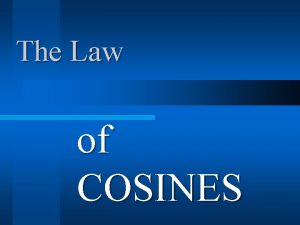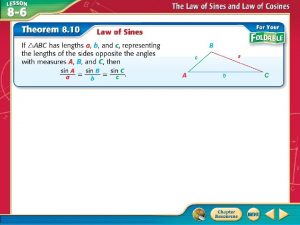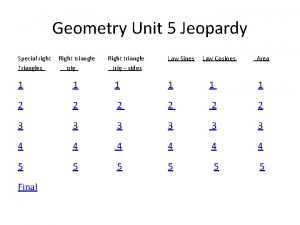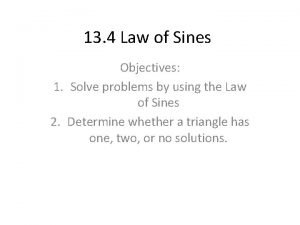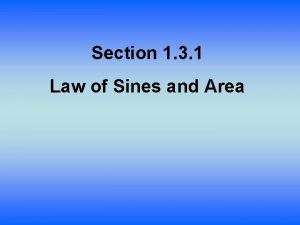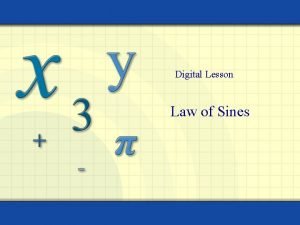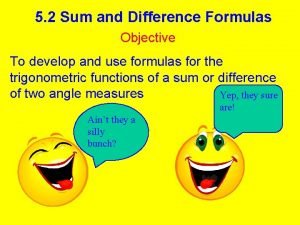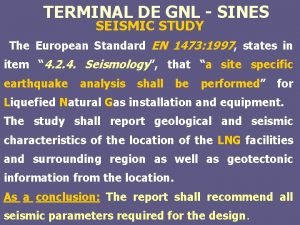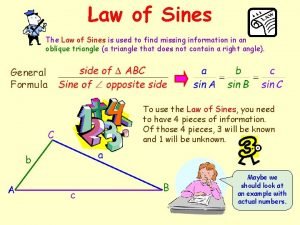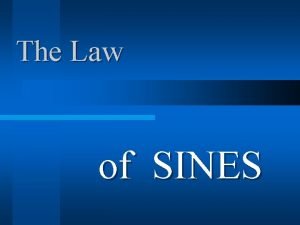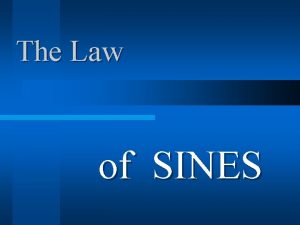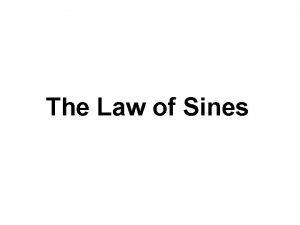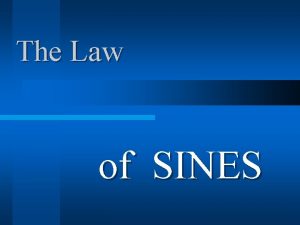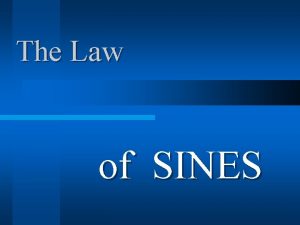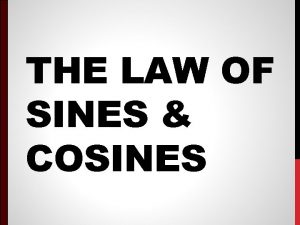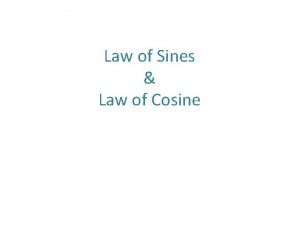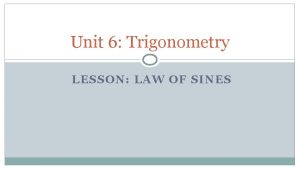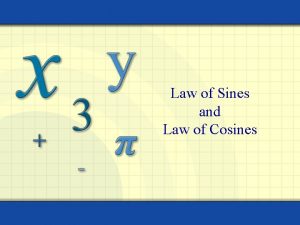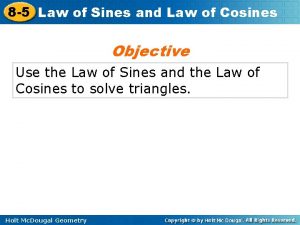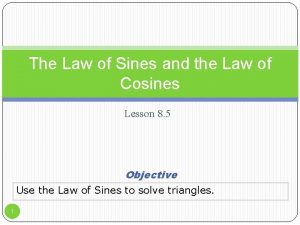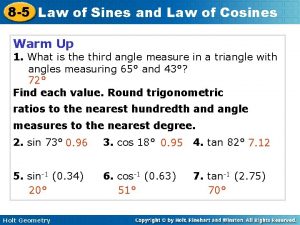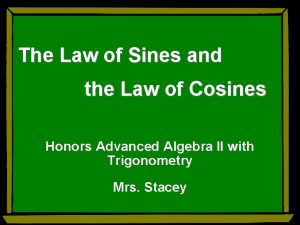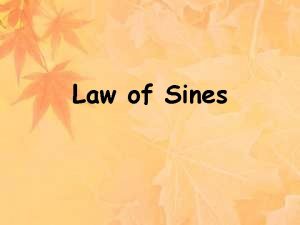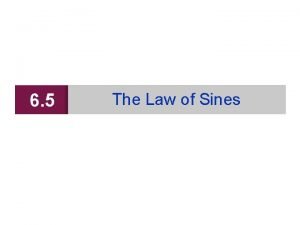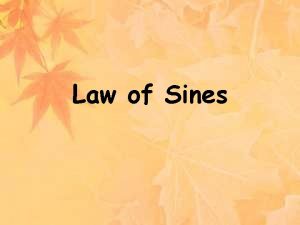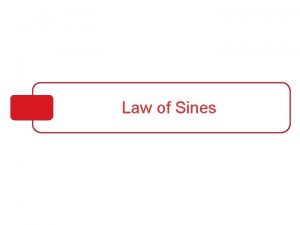LESSON 4 7 The Law of Sines and

















































- Slides: 49

LESSON 4– 7 The Law of Sines and the Law of Cosines

Five-Minute Check (over Lesson 4 -6) TEKS Then/Now New Vocabulary Key Concept: Law of Sines Example 1: Apply the Law of Sines (AAS) Example 2: Real-World Example: Apply the Law of Sines (ASA) Key Concept: The Ambiguous Case (SSA) Example 3: The Ambiguous Case—One or No Solution Example 4: The Ambiguous Case-Two Solutions Key Concept: Law of Cosines Example 5: Real-World Example: Apply the Law of Cosines (SSS) Example 6: Apply the Law of Cosines (SAS) Key Concept: Heron’s Formula Example 7: Heron’s Formula Key Concept: Area of a Triangle Given SAS Example 8: Find the Area of a Triangle Given SAS

Over Lesson 4 -6 Find the exact value of A. B. C. D. , if it exists.

Over Lesson 4 -6 Find the exact value of arctan (– 1), if it exists. A. B. C. D.

Over Lesson 4 -6 Find the exact value of A. B. C. D. , if it exists.

Over Lesson 4 -6 Sketch the graph of y = arctan (x + 2). A. C. B. D.

Over Lesson 4 -6 Find the exact value of A. B. C. D. , if it exists.

Targeted TEKS P. 4(G) Use the Law of Sines in mathematical and real-world problems. P. 4(H) Use the Law of Cosines in mathematical and real-world problems. Also addresses P. 4(F). Mathematical Processes P. 1(A), P. 1(G)

You solved right triangles using trigonometric functions. (Lesson 4 -1) • Solve oblique triangles using the Law of Sines or the Law of Cosines. • Find areas of oblique triangles.

• oblique triangles • Law of Sines • ambiguous case • Law of Cosines • Heron’s Formula


Apply the Law of Sines (AAS) Solve ΔLMN. Round side lengths to the nearest tenth and angle measures to the nearest degree. Because two angles are given, N = 180 o – (112 o + 29 o) or 39 o. Use the Law of Sines to find m and n.

Apply the Law of Sines (AAS) Law of Sines Substitution Multiply. Divide. Use a calculator. Therefore, N = 39°, m ≈ 42. 1, n ≈ 28. 6 Answer: N = 39°, m ≈ 42. 1, n ≈ 28. 6

Solve ΔXYZ. Round side lengths to the nearest tenth and angle measures to the nearest degree. A. y ≈ 11. 8, z ≈ 8. 0, Y = 75° B. y ≈ 8. 0, z ≈ 5. 3, Y = 85° C. y ≈ 28. 7, z ≈ 18. 9, Y = 95° D. y ≈ 14. 6, z ≈ 9. 9, Y = 75°

Apply the Law of Sines (ASA) BALLOONING A person in a hot-air balloon observes that the angle of depression to a building on the ground is 65. 8°. After ascending 500 feet, the person now observes that the angle of depression is 70. 2°. How far is the balloonist from the building? Draw a figure showing the situation.

TREE A tree is leaning 10° past vertical as shown in the figure. A wire that makes a 42° angle with the ground 10 feet from the base of the tree is attached to the top of the tree. How tall is the tree? A. 6. 8 ft B. 7. 8 ft C. 14. 3 ft D. 10. 9 ft


The Ambiguous Case—One or No Solution A. Find all solutions for the given triangle, if possible. If no solution exists, write no solution. Round side lengths to the nearest tenth and angle measures to the nearest degree. A = 63°, a = 18, b = 25 Notice that A is acute and a < b because 18 < 25. Find h.

The Ambiguous Case—One or No Solution Definition of sine h = b sin A or about 22. 3 Because a < h, no triangle can be formed with sides a = 18, b = 25, and A = 63°. Therefore, the problem has no solution. Answer: no solution

The Ambiguous Case—One or No Solution B. Find all solutions for the given triangle, if possible. If no solution exists, write no solution. Round side lengths to the nearest tenth and angle measures to the nearest degree. A = 105°, a = 73, b = 55 Notice that A is obtuse and a > b because 73 > 55. Therefore, one solution exists. Apply the Law of Sines to find B.

The Ambiguous Case—One or No Solution Law of Sines Multiply each side by 55. Definition of sin– 1 B ≈ 46. 7° Use a calculator. Because two angles are now known, C ≈ 180° – (105° – 46. 7°) or about 28. 3°. Apply the Law of Sines to find c. Choose the ratios with the fewest calculated values to ensure greater accuracy.

The Ambiguous Case—One or No Solution Law of Sines Solve for c. Therefore, the remaining measures of ΔABC are B ≈ 47°, C ≈ 28°, c ≈ 35. 8. Answer: B ≈ 47°, C ≈ 28°, c ≈ 35. 8

Find all solutions for ΔABC where a = 18, b = 13, and A = 126 o, if possible. If no solution exists, write no solution. Round side lengths to the nearest tenth and angle measures to the nearest degree. A. B ≈ 42°, C ≈ 12°, c ≈ 4. 6 B. B ≈ 28°, C ≈ 26°, c ≈ 9. 8 C. B ≈ 36°, C ≈ 18°, c ≈ 6. 9 D. no solution

The Ambiguous Case-Two Solutions Find two triangles for which A = 45°, a = 18, and c = 24. Round side lengths to the nearest tenth and angle measures to the nearest degree. A is acute, and h = 24 sin 45 o or about 17. 0. Notice that a < c because 18 < 24, and a > h because 18 > 17. 0. Therefore, two different triangles are possible with the given angle and side measures. Angle C will be acute, while angle C' will be obtuse.

The Ambiguous Case-Two Solutions Make a reasonable sketch of each triangle and apply the Law of Sines to find each solution. Start with the case in which C is acute. Solution 1 C is acute. Find C. Law of Sines Definition of sin– 1 sin C ≈ 0. 9428 C ≈ sin– 10. 9428 or about 70. 529° Use a calculator. Solve for sin C.

The Ambiguous Case-Two Solutions Find B. B ≈ 180° – (70. 53° + 45°) or about 64. 47° Apply the Law of Sines to find b. sin 64. 47° 18 sin 64. 47° Law of Sines

The Ambiguous Case-Two Solutions Solution 2 C' is obtuse. Note that m BC'C m BCC'. To find C', you need to find an obtuse angle with a sine that is also 0. 9428. To do this, subtract the measure given by your calculator to the nearest degree, 70. 53 o, from 180 o. Therefore, C' is approximately 180 o – 70. 53 o or 109. 47 o. Find B. B ≈ 180° – (109. 47° + 45°) or 25. 53

The Ambiguous Case-Two Solutions Apply the Law of Sines to find b. sin 25. 53° Law of Sines 18 sin 25. 53° Solve for b. Therefore, the missing measures for acute ΔABC are B ≈ 64°, C ≈ 71°, and b ≈ 23. 0, while the missing measures for obtuse ΔABC' are B ≈ 26°, C ≈ 109°, and b ≈ 11. 0 Answer: B ≈ 64°, C ≈ 71°, b ≈ 23. 0; B ≈ 26°, C ≈ 109°, b ≈ 11. 0

Find two triangles for which A = 24°, a = 13, and b = 15. Round side lengths to the nearest tenth and angle measures to the nearest degree. A. B ≈ 128°, C ≈ 28°, c ≈ 15. 0, B ≈ 4°, C ≈ 152°, c ≈ 17. 3 B. B ≈ 28°, C ≈ 128°, c ≈ 25. 2, B ≈ 152°, C ≈ 4°, c ≈ 2. 2 C. B ≈ 28°, C ≈ 128°, c ≈ 25. 2, B ≈ 62°, C ≈ 92°, c ≈ 31. 9 D. B ≈ 21°, C ≈ 135°, c ≈ 22. 6, B ≈ 69°, C ≈ 87°, c ≈ 31. 9


Apply the Law of Cosines (SSS) LANDSCAPING A triangular area of lawn has a sprinkler located at each vertex. If the sides of the lawn are a = 19 feet, b = 24. 3 feet, and c = 21. 8 feet, what angle of sweep should each sprinkler be set to cover? Since three side lengths are given, you can use the Law of Cosines to find the largest angle, B. b 2 = a 2 + c 2 – 2 ac cos B 24. 32 = 192 + 21. 82 – 2(19)(21. 8)cos B Law of Cosines a = 19, b = 24. 3, and c = 21. 8

Apply the Law of Cosines (SSS) 590. 49 = 361 + 475. 24 – 828. 4 cos B Simplify. 590. 49 = 836. 24 – 828. 4 cos B Add. – 245. 75 = – 828. 4 cos B Subtract 836. 24 from each side. Divide each side by – 828. 4. Use the cos– 1 function.

Apply the Law of Cosines (SSS) Use a calculator. Use the Law of Sines to find A. Law of Sines Solve for A. Then, find C. C ≈ 180° – (72. 7° + 48. 3°) C ≈ 59. 0°

Apply the Law of Cosines (SSS) The angle of sweep for A is about 48°, the angle of sweep for B is about 73°, and the angle of sweep for C is about 59°. Answer: A ≈ 48°, B ≈ 73°, C ≈ 59°.

LOT A triangular lot has sides of 120 feet, 186 feet, and 147 feet. Find the angle across from the shortest side. A. 9° B. 40° C. 49° D. 52°

Apply the Law of Cosines (SAS) Solve ΔABC. Round side lengths to the nearest tenth and angle measures to the nearest degree.

Apply the Law of Cosines (SAS) Step 1 Use the Law of Cosines to find the missing side measure. a 2 = b 2 + c 2 – 2 bc cos A Law of Cosines a 2 = 122 + 142 – 2(12)(14)cos 39. 4º b = 12, c = 14, and A = 39. 4 o a 2 ≈ 80. 36 a ≈ 9. 0 Use a calculator. Take the positive square root of each side.

Apply the Law of Cosines (SAS) Step 2 Use the Law of Sines to find a missing angle measure. Multiply each side by 12. B ≈ 57. 8° Definition of sin– 1

Apply the Law of Cosines (SAS) Step 3 Find the measure of the remaining angle. C ≈ 180° – (39. 4° + 57. 8°) or 82. 8° Therefore, a ≈ 9. 0, B ≈ 58°, and C ≈ 83°. Answer: a ≈ 9. 0, B ≈ 58°, C ≈ 83°

Solve ΔMNP if M = 54 o, n = 17, and p = 12. Round side lengths to the nearest tenth and angle measures to the nearest degree. A. m ≈ 193. 2, N ≈ 4°, P ≈ 122° B. m ≈ 13. 9, N ≈ 82°, P ≈ 44° C. m ≈ 17. 7, N ≈ 51°, P ≈ 75° D. m ≈ 16. 1, N ≈ 59°, P ≈ 67°


Heron’s Formula Find the area of ΔABC to the nearest tenth. . Heron's Formula s = 72, a = 47, b = 53, and c = 44

Heron’s Formula Simplify. Use a calculator. Answer: about 978. 6 ft 2

Find the area of ΔGHJ. A. 2790. 1 ft 2 B. 678. 0 ft 2 C. 191. 6 ft 2 D. 31. 9 ft 2


Find the Area of a Triangle Given SAS Find the area of ΔABC to the nearest tenth. In ΔABC, b = 39, c = 52, and A = 25. 89 o. Area of a triangle using SAS Substitution. Simplify.

Find the Area of a Triangle Given SAS So, the area is about 442. 8 in 2. Answer: about 442. 8 in 2

Find the area of ΔDEF to the nearest tenth. A. 652. 4 cm 2 B. 326. 2 cm 2 C. 224. 6 cm 2 D. 112. 3 cm 2

LESSON 4– 7 The Law of Sines and the Law of Cosines
 8-6 the law of sines and law of cosines
8-6 the law of sines and law of cosines Law of sines sss
Law of sines sss 8-6 the law of sines
8-6 the law of sines 8-5 law of sines
8-5 law of sines Law of sines lesson plan
Law of sines lesson plan Law of sines lesson
Law of sines lesson Trigonometry magic triangles
Trigonometry magic triangles Ass triangle
Ass triangle Sohcahtoa problems
Sohcahtoa problems What is a unique triangle
What is a unique triangle Law of cosines test
Law of cosines test 12-4 practice law of sines
12-4 practice law of sines Law of sines formula ssa
Law of sines formula ssa 12-4 law of sines
12-4 law of sines 12-4 law of sines
12-4 law of sines Law of sines area formula
Law of sines area formula Hot angles
Hot angles Law of sines sss
Law of sines sss Asa law of sines
Asa law of sines Law of sines
Law of sines Law of sines area
Law of sines area Sss formula
Sss formula Ambiguous case sine rule
Ambiguous case sine rule Example of an oblique triangle
Example of an oblique triangle Newton's first law and second law and third law
Newton's first law and second law and third law Newton's first law of motion
Newton's first law of motion Boyles law
Boyles law P=k/v
P=k/v 135628
135628 Sum or difference formula
Sum or difference formula Terminal gnl sines
Terminal gnl sines Hát kết hợp bộ gõ cơ thể
Hát kết hợp bộ gõ cơ thể Bổ thể
Bổ thể Tỉ lệ cơ thể trẻ em
Tỉ lệ cơ thể trẻ em Voi kéo gỗ như thế nào
Voi kéo gỗ như thế nào Glasgow thang điểm
Glasgow thang điểm Alleluia hat len nguoi oi
Alleluia hat len nguoi oi Các môn thể thao bắt đầu bằng từ đua
Các môn thể thao bắt đầu bằng từ đua Thế nào là hệ số cao nhất
Thế nào là hệ số cao nhất Các châu lục và đại dương trên thế giới
Các châu lục và đại dương trên thế giới Cong thức tính động năng
Cong thức tính động năng Trời xanh đây là của chúng ta thể thơ
Trời xanh đây là của chúng ta thể thơ Mật thư anh em như thể tay chân
Mật thư anh em như thể tay chân Phép trừ bù
Phép trừ bù Phản ứng thế ankan
Phản ứng thế ankan Các châu lục và đại dương trên thế giới
Các châu lục và đại dương trên thế giới Thơ thất ngôn tứ tuyệt đường luật
Thơ thất ngôn tứ tuyệt đường luật Quá trình desamine hóa có thể tạo ra
Quá trình desamine hóa có thể tạo ra Một số thể thơ truyền thống
Một số thể thơ truyền thống
